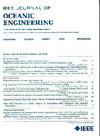A Vignetting-Correction-Based Underwater Image Enhancement Method for AUV With Artificial Light
IF 3.8
2区 工程技术
Q1 ENGINEERING, CIVIL
引用次数: 0
Abstract
Images captured by autonomous underwater vehicles (AUVs) are inherently affected by artificial light, which tends to generate distinctive footprint and biased veiling light on the foreground. Existing underwater image enhancement (UIE) methods do not take this serious problem into account. In practice, the enhanced results will lead to a severe performance drop, due to the challenging joint task of enhancing underwater images while correcting the vignetting phenomenon. To solve this issue, we propose a two-stage vignetting-correction driven UIE network (called VCU-Net), which consists of two subnetworks (vignetting-correction-net and restoration-net), to deal with the two joint tasks in a split way. Concretely, we first introduce a novel underwater imaging model that is more capable of describing the imaging process for underwater robot applications. Accordingly, sufficient underwater data with vignetting is conducted to train our VCU-Net. In addition, based on the intensity distribution statistics of the lighting footprint formed by artificial light, a radial gradient constrained loss is designed in the vignetting-correction-net, which facilitates the precise estimation of vignetting. To validate the performance, extensive experiments on both synthetic and real-world images captured with AUV show the effectiveness of the proposed novel method, which illustrates a great superiority against the state-of-the-art methods in real underwater world with complex illumination.基于渐晕校正的人工光AUV水下图像增强方法
自主水下航行器(auv)捕获的图像本质上受到人造光的影响,这往往会在前景上产生独特的足迹和偏颇的遮蔽光。现有的水下图像增强(UIE)方法并没有考虑到这个严重的问题。在实际应用中,增强后的结果会导致性能严重下降,因为在校正渐晕现象的同时增强水下图像是一项具有挑战性的联合任务。为了解决这一问题,我们提出了一种两阶段渐晕校正驱动的UIE网络(称为VCU-Net),该网络由两个子网(渐晕校正网和恢复网)组成,以分裂的方式处理两个联合任务。具体而言,我们首先介绍了一种新的水下成像模型,该模型更能描述水下机器人应用的成像过程。因此,利用充分的带渐晕的水下数据来训练我们的VCU-Net。此外,基于人造光形成的光足迹的强度分布统计,在渐晕校正网中设计了径向梯度约束损失,便于对渐晕进行精确估计。为了验证该方法的性能,对水下航行器捕获的合成图像和真实图像进行了大量实验,证明了该方法的有效性,在具有复杂光照的真实水下世界中,该方法与最先进的方法相比具有很大的优势。
本文章由计算机程序翻译,如有差异,请以英文原文为准。
求助全文
约1分钟内获得全文
求助全文
来源期刊

IEEE Journal of Oceanic Engineering
工程技术-工程:大洋
CiteScore
9.60
自引率
12.20%
发文量
86
审稿时长
12 months
期刊介绍:
The IEEE Journal of Oceanic Engineering (ISSN 0364-9059) is the online-only quarterly publication of the IEEE Oceanic Engineering Society (IEEE OES). The scope of the Journal is the field of interest of the IEEE OES, which encompasses all aspects of science, engineering, and technology that address research, development, and operations pertaining to all bodies of water. This includes the creation of new capabilities and technologies from concept design through prototypes, testing, and operational systems to sense, explore, understand, develop, use, and responsibly manage natural resources.
 求助内容:
求助内容: 应助结果提醒方式:
应助结果提醒方式:


